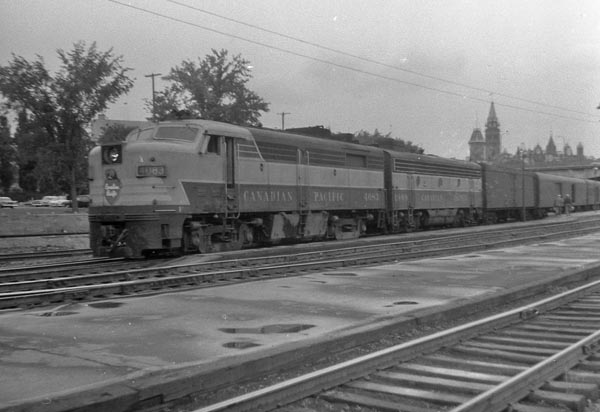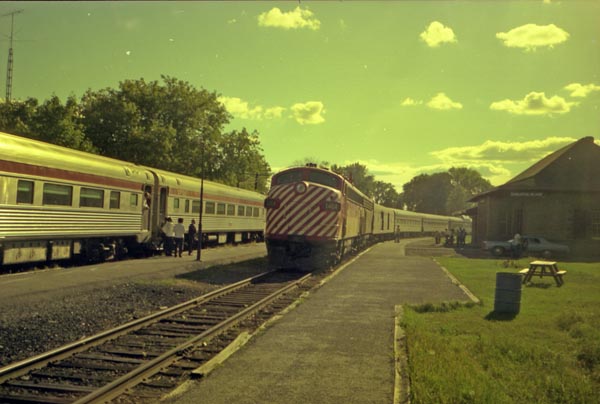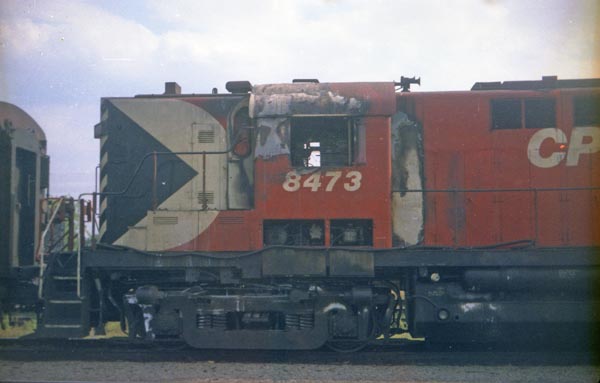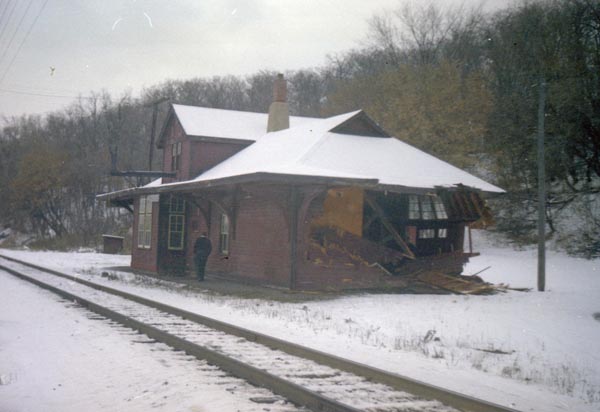
|
Recently I got to thinking
about some of the days gone by on CP in and around the Ottawa area in
the 1970s. Perhaps as time colours everything to a certain extent,
memories of this era seem to get fonder and fonder.
I am reminded particularly about some trips by the late Bill Austin, a CP engineer. In freight service. Bill was average. When he was on the run to Hilton Mines, near Quyon, Quebec, he could take his time; when off the main line, engineers received pay at the rate of 18.75 cents per mile, which was time-and-one-half when compared to main line pay at 12.5 cents per mile. The operator at Quyon used to have to weigh every car from both Hilton Mines and Franceschini Pit (the latter was five miles west of Shawville), and if the engineer was Austin, the guy working Quyon knew that the crew would have a long day at the mine. Once back at Quyon, the train crew would want a rapid weighing of the train. Passenger service was something else. Aside from the late Earl Glenn, Bill could also turn a wheel pretty fast. In the early-1970s, when CP began putting the heavy SD40 units on the Chalk River Subdivision (Ontario), they seemed to tear up the rails pretty quickly. Of 100-lb. weight, the rails were not the newest, so relay rail had to be installed. That took time, however, so for a couple of years a 50 mph slow order was placed on the Subdivision. The crews all knew that it was meant mostly for big power, and the damage it was causing, so Bill kept his usual speed when on Nos. 1 and 2, "The Canadian". His alternate engineer, Don Henry, religiously stuck to the 50 mph speed and often Dispatchers had to put Bill, who would be on No. 2, in the siding when he met No. 1, just so No. 1 would go into Chalk River on time. One time. Track Recorder Car No. 63 was on No. 1. Upon an on-time arrival at Chalk River, the track engineer on Car 63 quickly approached the engines on No. 1 as Bill was disembarking. "Do you realize you were going 93 mph through Cobden?" Bill calmly replied "is that all ... the speedometer read 102!" Several of the older FP7s on CP's roster, although only geared for 89 mph, had no overspeed on them and could go somewhat faster that the rules allowed. Before its demise, I remember riding No. 8 ("The Dominion") from Carleton Place to Ottawa with FPA-2 4083 and F9B 1909 for power. We were going 93 mph through Stittsville when the brakes went on in the 1909, which was geared for 89. The 4083 was only geared for 75, but that class also had no overspeed, at times.  4083 and 1909 on The Dominion at Ottawa on 14 June 1965, after the overspeed incident at Stittsville mentioned above. I've also been told that if the unit was not in 8th gearing, the maximum gearing did not apply. I was riding No. 2 from Thunder Bay to Schreiber in 1975 with FP9 1406 geared for 89 mph and GP9 8514 geared for 65 mph, and we were going a mile in 38 seconds (95 mph)!  Bill Austin bringing The Canadian into Carleton Place on his last day - 26 August 1974 Anyway ... No. 2 showed up on the interlocking plant at Snedden only about five minutes late, and was only two minutes late at Carleton Place. I hopped on the lead 1400 and wished Bill well, noticing several gifts given to him at Chalk River by his co-workers. He even had a few bows on the cab windows. After an uneventful trip, we pulled into Ottawa a couple of minutes early to a welcoming committee of his family and other Ottawa crews.  Bill
Austin approaching Ottawa on his last day - 26 August 1974.
I went back to the train and had dinner in the diner. I then went up to
the Skyline car for the rest of the trip to Montreal. While passing
through St. Eugene at about 70 mph, one woman several seats behind me
remarked "we're going pretty fast, aren't we?" One of her fellow
travellers piped up "This is nothing, you should have seen us around
Renfrew this afternoon, we were just about in the aisles!"Other shenanigans involved the reballasting of the Chalk River Subdivision with Messrs. Henry and Austin on Nos. 1 and 2 in the early-1 970s. One Saturday afternoon the wayfreight (No. 72), with BRS member Don Gaw as Conductor, pulled into Smiths Falls with a handful of cars. There was a train order out, "Siding Kathmae blocked with cars." However, the train dumping the slag had taken all the empties into Chalk River. Behind No. 72 was No. 74 with 48 cars of ballast, billed to Pembroke, where the work train was stored for the weekend. Behind No. 74 was No. 952, the Seaboard freight, which was "Hot Hot". Then, behind No. 952 was No. 2 with Mr. Austin engineering. Opposing these trains were No. 911, the Soo freight, with the usual assortment of first generation relics, an old Alco "A" unit and two almost-as-elderly RS-3s, with about 10 loads and 70 empties. Then, an hour behind him, was No. 1 with Mr. Henry engineering. The Dispatcher noticed Mr. Gaw walking down the platform to book in No. 72 and, after the usual pleasantries were exchanged about this, that, and the other thing, remarked, "It looks like a good meet with 1 and 2 at Kathmae, Don; was the siding clear?" "Yes, all the empties were at Chalk River for 911 to lift back to Sudbury." At Sudbury, the cars were loaded with slag at the giant International Nickel Company plant. "Great!" The Dispatcher then put out a 19Y order to Chalk River to No. 2, and at Renfrew to No. 1, telling them to meet at Kathmae. This meant that No. 1 was cleared to Renfrew, and No. 2 to Chalk River, and away they both went. On this Saturday afternoon, the Dispatcher in Smiths Falls was also looking after the rest of the Smiths Falls Division which included the double track from Smiths Falls to Montreal, the branches out fo Ottawa including the Maniwaki, Waltham and Prescott Subdivisions, the Brockville Subdivision, and the Eganville which was about to be demolished. About 20 minutes later the Dispatcher noticed No. 74's conductor, Mr. H.F. Row, walking towards the station and opened the window to exchange pleasantries with him. In the course of the conversation he asked, "Say Had, where did you set off your 48 cars of slag?" "In the siding at Kathmae." You could feel the pain in your chest about then of an impending heart attack. There is no back track at Kathmae and the siding holds 52 cars. Just then the dispatcher's phone crackled to life. "Hello, dispatcher, Kathmae." "What are you going to do with us here, double deck us?" "Just a minute!" "Hello Pembroke?" "Where is No. 2?" "Just pulling in." "Well, take a 19R for him and put your order board signal at red. No. 74 just filled up the siding at Kathmae, so No. 2 will have to wait there while No. 1 gets advanced from Kathmae." Kathmae was 6.5 miles from Pembroke, so that took about 10 minutes for No. 1 to advance to Pembroke - delaying Mr. Austin by that amount, which he didn't appreciate - especially on a Saturday evening. The other two passenger stories on the Chalk River Sub. involved Don Henry. One Saturday afternoon, No. 1 was out of Pembroke with FP9 1406 and RS-10 8473. Seven minutes after leaving Pembroke, the fireman on No. 1 was on the phone: "Dispatcher, Stafford, our second engine is on fire ... get Pembroke to call the fire department." The firemen arrived within 1 5 minutes, but the engine cab was gutted and the 8473 was retired shortly after. Apparently a fuel line in the cab had ruptured and sprayed hot fuel all over the interior. When the locomotive had a surge when making transition, the fuel ignited.  8473 at Smiths Falls after the fire at Stafford 9 September, 1971. Another time No. 2 was cruising at about 75 mph at the River Road crossing immediately west of Braeside when it was hit by a runaway garbage truck which was careening down the side of the escarpment there, headed for the Ottawa River. The train was broadsided by the truck, the impact throwing the hapless vehicle into the side of the Braeside station. Fortunately the station was unoccupied, having been recently closed when the Customer Service Centre for the Smiths Falls Division opened at Walkey Yard in Ottawa.  The west side of Braeside station on 11 November 1971 after being hit by a garbage truck on 6 November 1971. The station had been closed since September 1969. There was no fire nor were there any fatalities, excepting the station which was pretty well crushed at the west side. Although the driver suffered no visible injuries, he probably needed a change of underwear! I don't know which is worse, getting hit by a 75 mph train or going into the Ottawa River with a full load of garbage right behind you! The episode delayed No. 2 about 30 minutes. Many of us may well lament the passing of steam but, railroading being the business and practise that it is, there will be stories to tell, no matter what the era. Bytown Railway Society, Branchline, February 2008, page 17. |
![]()